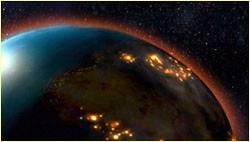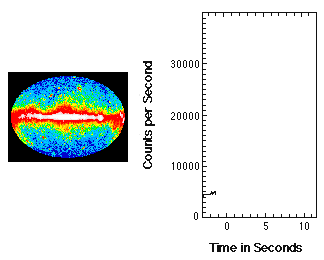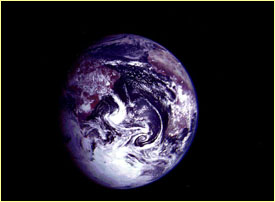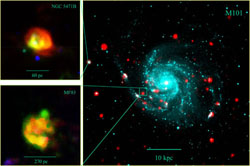 |
 |
|
|
 If a burster
exploded within, say, 3,000 light-years of Earth, our prospects would not be
rosy.
If a burster
exploded within, say, 3,000 light-years of Earth, our prospects would not be
rosy.
|
A Bad Day in the Milky Way
Part 2 | Back to Part 1
How much ozone would be destroyed? Thorsett estimated that if the burster were
located near the center of our galaxy, some 30,000 light-years away, the ozone
depletion would be a few percent, comparable to that produced by natural
disasters like large volcanic eruptions, very intense solar flares, or even a
meteor impact on the scale of the one that exploded over Tunguska, Siberia in
1908.
If the burster were closer, say less than 3,000 light-years away, the gamma-ray
flux received in a few tens of seconds could wipe out the entire ozone layer
for years to come. At the very least, the drastic increase in solar ultraviolet
radiation reaching Earth's surface would cause severe skin cancers. For humans
and other animals, slow starvation would likely result, as the harmful
ultraviolet flux inhibited plant growth and damaged and altered ecosystems
supporting the food chain. As in a nuclear winter, the nitric oxides darkening
our skies could also cause acid rains and significant cooling of the Earth's
surface. Such pollutants would take decades to settle out of the
stratosphere.
 In the false-color gamma-ray
all-sky map at left, a burster suddenly appears, briefly overwhelms all other
celestial gamma rays, then vanishes. The graph at right shows the burst as it
was detected by the Compton Gamma Ray Observatory.
In the false-color gamma-ray
all-sky map at left, a burster suddenly appears, briefly overwhelms all other
celestial gamma rays, then vanishes. The graph at right shows the burst as it
was detected by the Compton Gamma Ray Observatory.
|
|
But that's not all. In addition to the chemical changes in the atmosphere, the
nuclear interactions induced by the high-energy gamma rays would rapidly
produce huge quantities of radioactive nucleids, such as carbon-14, which has a
half-life of 5,700 years. Of course, winds would distribute this fallout
worldwide.
It gets worse
Depending on what the mechanism for producing a gamma-ray burst actually is, a
nearby burst could wreak even more havoc. Nir Shaviv and Arnon Dar of the
Israel Institute of Technology have explored a particularly devastating model
for generating gamma-ray bursts from co-orbiting pairs of neutron stars. All
neutron star pairs eventually spiral together, losing energy through
gravitational radiation as predicted by Einstein's theory of general
relativity.
Shaviv and Dar postulate that as the neutron stars begin their own catastrophic
merger, jets of matter would be flung from the system at nearly the speed of
light. These atoms and ions would be so energetic that they would absorb
visible starlight and re-emit gamma rays, which we would detect as a gamma-ray
burst. Impinging on our fair planet shortly after the horrific flash of gamma
rays, the energetic particles themselves would join in the destruction,
triggering still more deadly atmospheric cascades of nuclear interactions
lasting up to a month.
|
 If Shaviv and Dar are
correct, a collapsing binary neutron star system anywhere nearby would spell
doom for our fair planet.
If Shaviv and Dar are
correct, a collapsing binary neutron star system anywhere nearby would spell
doom for our fair planet.
|
These authors and others note that known pairs of neutron stars exist in our
galaxy, including one within about 1,500 light-years. This knowledge has led to
the speculation that in the past the Earth has found itself uncomfortably close
to a violent neutron star merger. Some estimates hold that one occurs within
about 3,000 light-years of the sun every 100 million years on average.
Intriguingly, this timescale is roughly the same as the time between mass
extinctions in our planet's geological record.
Learn to love the burst
One shouldn't worry too much, though. For one thing, mass extinctions in the
past might have been the result of purely terrestrial phenomena, such as
climatic changes produced by plate tectonics and volcanic activity, or of more
familiar kinds of cosmic disasters, like the asteroid impact thought to have
caused the dinosaur extinction at the end of the Cretaceous Period. For
another, even if the aforementioned scenarios turned out to be true, we would
still have, statistically speaking, about 50 million years until the next
gamma-ray burst of doom.
Which gives us time to get to know bursters better. Our understanding of them
constantly changes as new findings are reported. For instance, recent afterglow
studies have indicated that a burst's energy is beamed in a particular
direction rather than radiating in all directions from the source,
substantially reducing the burster's total energy requirement.
 This image shows M101, a nearby spiral galaxy, which
bears two candidates for possible hypernovae—hypothesized explosions of
high-mass stars that release perhaps ten times the energy of conventional
supernovae.
This image shows M101, a nearby spiral galaxy, which
bears two candidates for possible hypernovae—hypothesized explosions of
high-mass stars that release perhaps ten times the energy of conventional
supernovae.
|
|
Moreover, even after three decades of study, the true nature of gamma-ray
bursts remains unknown. Many astrophysicists have taken a shine to a new
theory, which for the moment has eclipsed the neutron-star-merger scenario in
popularity. Evidence is mounting that at least some bursters are more likely
associated with star-forming regions than with binary neutron stars.
Theoretical models now in vogue indicate that gamma-ray bursts result from
"hypernovae"—the collapse of the cores of extremely short-lived massive
stars into black holes.
Another theory actually paints gamma-ray bursts in a positive light. University
College Dublin researchers Brian McBreen and Lorraine Hanlon recently estimated
the effects of a nearby gamma-ray burst on the preplanetary solar nebula, the
cloud of condensing star stuff that formed our solar system some 4.5 billion
years ago. They calculated that iron in the nebula would have been the major
absorber of the high-energy X-rays and gamma rays from such a burst, causing
the nebula's dust to become molten in seconds and then cooling slowly to form
millimeter-sized chondrules, round granules of cosmic origin. Chondrules, they
note, combined to form meteorites and possibly the rocky terrestrial planets,
including Earth.
So, you see, despite the gloom-and-doom scenario I painted above, perhaps we
should call them bursts of life.

|
|
Dr. Jerry Bonnell is an astrophysicist at Goddard Space Flight Center's
Laboratory for High-Energy Astrophysics in Greenbelt, Maryland. Fame and
fortune dog his every step as he studies gamma-ray bursts and co-edits the
Astronomy Picture of the Day Web site (http://apod.gsfc.nasa.gov).
|
Photo credits
One Astronomer's Universe |
A Bad Day in the Milky Way
Catalogue of the Cosmos |
Tour the Spectrum
Resources |
Transcript |
Site Map |
Death Star Home
Search |
Site Map |
Previously Featured |
Schedule |
Feedback |
Teachers |
Shop
Join Us/E-Mail |
About NOVA |
Editor's Picks |
Watch NOVAs online |
To print
PBS Online |
NOVA Online |
WGBH
© | Updated January 2002
|
|
|
|